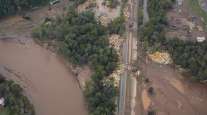FHWA Proposes Primary Freight Network Designation
The Federal Highway Administration unveiled Nov. 18 the draft of the nation’s first ever Primary Freight Network — 26,966 centerline miles of roadway deemed most critical to freight movement.
Another 41,518 miles also was designated as critical to freight movement, largely through rural and less populated states such as Montana, North and South Dakota and Vermont.
"Freight movement is the lifeblood of the American economy," Transportation Secretary Anthony Foxx said in a statement. "To create jobs, remain competitive and strengthen the economy, we must develop a more strategic approach to moving freight, and identifying the highways that are most critical for freight is a key part of that effort."
Congress asked FHWA to designate the Primary Freight Network and a National Freight Network in last year’s MAP-21. The network designation does not provide additional funding, but states can use their regular federal money to pay for up to 95% of the cost of work on highways that are critical to the movement of freight.
The National Freight Network is to contain three components — the Primary Freight Network, all interstate highways not included in the Primary Freight Network and the Critical Rural Freight Corridors.
Congress originally called for an initial network of not more than 27,000 miles but later added provisions for rural roads that are critical to freight movement.




